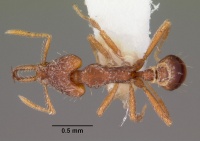Strumigenys sytaria
| Strumigenys sytaria | |
|---|---|

| |
| Scientific classification | |
| Kingdom: | Animalia |
| Phylum: | Arthropoda |
| Class: | Insecta |
| Order: | Hymenoptera |
| Family: | Formicidae |
| Subfamily: | Myrmicinae |
| Tribe: | Attini |
| Genus: | Strumigenys |
| Species: | S. sytaria |
| Binomial name | |
| Strumigenys sytaria Bolton, 2000 | |
Nothing is known about the biology of Strumigenys sytaria.
Identification
Bolton (2000) - A member of the signeae complex in the Strumigenys godeffroyi-group. Closely related to Strumigenys valefor and with a very similarly developed crest on the inner mandibular margin. Apart from having the metapleuron and side of propodeum punctate (smooth in valefor), sytaria differs from vale/or as the former lacks stiffly elevated hairs on the hind femur, has a narrow lamella on the propodeal declivity, has the pronotal dorsum densely punctate and lacks an anteromedian pair of short erect hairs on the pronotal dorsum. See notes under Strumigenys mocsaryi.
Keys including this Species
Distribution
Distribution based on Regional Taxon Lists
Indo-Australian Region: Borneo (type locality), Indonesia, Malaysia.
Distribution based on AntMaps
Distribution based on AntWeb specimens
Check data from AntWeb
Countries Occupied
| Number of countries occupied by this species based on AntWiki Regional Taxon Lists. In general, fewer countries occupied indicates a narrower range, while more countries indicates a more widespread species. |

|
Estimated Abundance
| Relative abundance based on number of AntMaps records per species (this species within the purple bar). Fewer records (to the left) indicates a less abundant/encountered species while more records (to the right) indicates more abundant/encountered species. |

|
Biology
Castes
Nomenclature
The following information is derived from Barry Bolton's Online Catalogue of the Ants of the World.
- sytaria. Strumigenys sytaria Bolton, 2000: 829 (w.q.) BORNEO.
Unless otherwise noted the text for the remainder of this section is reported from the publication that includes the original description.
Description
Worker
Holotype. TL 2.8, HL 0.77, HW 0.57, CI 74, ML 0.38, MI 49, SL 0.42, SI 74, PW 0.32, AL 0.74. Characters of signeae-complex. Inner margin of mandible with a very narrow cuticular crest that extends from base but peters out proximally well before level of preapical tooth; this crest no more than a minute rim or carina and at its broadest no more than a tiny fraction of the width of the mandible. Apicoscrobal hair stiff; dorsolateral margin of head posterior to this with 3-4 similar but shorter projecting hairs. Cephalic dorsum with a transverse row of 4-6 erect hairs at occipital margin; without standing hairs anterior to this. Pronotal humeral hair stiff and simple; pronotal dorsum otherwise without erect hairs. Mesonotum with 3 conspicuous pairs of erect simple to weakly remiform hairs, the anterior pair the longest. Entire dorsal alitrunk finely punctulate to reticulate-punctulate. Katepisternum mostly smooth but side of alitrunk otherwise entirely reticulate-punctate. Lamella on propodeal declivity narrow, its posterior (free) margin usually concave. Petiole node in dorsal view broader than long, reticulate-punctate. In profile lateral spongiform lobe of petiole small, confined to posterolateral portion of node; height of anterior face of node less than length of dorsum. Disc of postpetiole finely evenly superficially punctulate (variable, see under paratypes). First gastral tergite with simple standing hairs. Basigastral costulae shorter than disc of postpetiole.
Paratypes. TL 2.6-2.8, HL 0.73-0.78, HW 0.53-0.57, CI 73-75, ML 0.34-0.38, MI 46-49, SL 0.39-0.43, SI 72-78, PW 0.29-0.32, AL 0.70-0.74 (6 measured). As holotype but density and intensity of sculpture on postpetiole disc varying from almost entirely smooth to completely finely punctulate, and in some with weak longitudinal costulae also apparent.
Type Material
Holotype worker, Malaysia: Sabah, Crocker Ra., 17.v.1987, 1350 m., no. 28a (Burckhardt & Lobl) (Musee d'Histoire Naturelle Genève).
Paratypes. 5 workers with same data as holotype; 4 workers and 1 queen with same locality but 19.v.1987, 1200 m., no. 31a; 3 workers, Sabah, Crocker Ra. N. P., K. K. -Tambunan km. 60, 17.v.0987, 1270 m., no. 29a (Burckhardt & Lobl); 7 workers, Sabah, Mt Kinabalu, 24.v. 1 987, 1 140 m., no. 40 (Burckhardt & Lobl) (MHNG, The Natural History Museum, Museum of Comparative Zoology).
References
- Bolton, B. 2000. The ant tribe Dacetini. Memoirs of the American Entomological Institute. 65:1-1028. (page 829, worker described)
References based on Global Ant Biodiversity Informatics
- Pfeiffer M.; Mezger, D.; Hosoishi, S.; Bakhtiar, E. Y.; Kohout, R. J. 2011. The Formicidae of Borneo (Insecta: Hymenoptera): a preliminary species list. Asian Myrmecology 4:9-58

